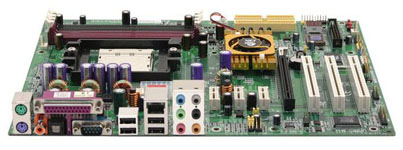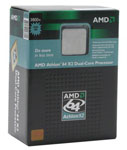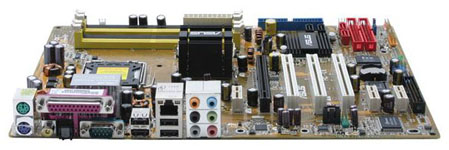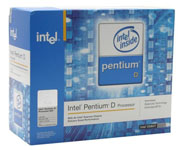Mid-Range Buyer's Guide, September 2005
by Jarred Walton on September 19, 2005 12:05 AM EST- Posted in
- Guides
Office CPU and Motherboard Recommendations
For the non-gaming configurations (which we're loosely terming "office" here), our motherboard and processor picks are very different. While dual core at present does little to nothing for gaming other than to increase costs (or allow you to run applications in the background while gaming), the same is not true of non-gaming applications. Many professional business applications are already optimized to support SMP (Symmetric Multi-Processing - in other words, multiple CPU cores) configurations. Video encoding, image editing, 3D rendering, and software development can all take advantage of the second CPU core. At the same time, even the cheapest of modern graphics cards is more than sufficient for most non-gaming work. There's a reason why Intel currently has more installed graphics chips than anyone else: for business use, integrated graphics are perfectly adequate. Multitasking will also benefit from the addition of a second CPU core, so burning a DVD while surfing the web, running your virus scanner, etc. shound't be a problem.
Here, Intel has the clear advantage, simply in terms of pricing. While the Intel Pentium D chips are not as fast as the AMD X2 chips, we're less concerned with maximum performance than we are with having a second core. DVD burning and web browsing aren't going to max out even a single CPU core, but the context switching that the CPU has to do in order to run both tasks at the same time can have an impact (especially under Windows XP). If you're running two CPU intensive tasks, of course, dual cores will be tremendously helpful. We've labeled this setup as "Office", but it is also useful for non-business tasks, with DVD playback/ripping/encoding, PVR duties, and even moderate gaming topping the list. In short, they're good systems for homes as well as businesses.
AMD Office Motherboard: EPoX EP-9NPA+Ultra
Price: $98 shipped
AMD Office CPU: Athlon 64 X2 3800+ 2x512K 2.0GHz
Price: $361 shipped (Retail)
Total: $459
If gaming isn't a primary concern, the use case for SLI is greatly diminished. Sure, you can use the second slot for a non-graphic device, but most of those will be fine in an X1 or X2 slot instead. Given the current price premium for SLI boards - especially the higher-quality boards - we're going to skip that for our business configuration. The EPoX EP-9NPA+Ultra received top marks in our nForce4 Ultra Roundup, and at under $100, it's a great bargain. Paired with the lowest priced Athlon X2 part, the 3800+, we still end up spending around $150 more for the motherboard and CPU relative to our Gaming configuration, but we'll save that money elsewhere. This is a potent combination and should meet just about any business/home needs for several years. About the only additions that might be required in the next year or two are a new graphics card, more data storage, and/or more RAM. (You'll probably be upgrading the OS at some point as well.)
While we've said that Intel has the pricing advantage, we really need to qualify that statement. Yes, the X3800+ is substantially more expensive than the Pentium D 820 (and even the 830 is cheaper). The quality Intel motherboards do cost a bit more, however, making the Pentium D 830 a roughly equal price. If you look at the single core foundation of the parts rather than the model number, though, you get some interesting details. A single 2.0GHz 512K AMD core is called the 3200+, making it roughly the equal of the Pentium 4 540 3.2GHz. Two of these cores comprise the X2 3800+, while two 3.2GHz Prescott cores make the Pentium D 840. The 840 actually retails for substantially more than the X2 3800+, so comparing the 3800+ and the 820 is hardly fair. While there are a few applications where the Pentium D wins out in raw performance, the X2 3800+ is definitely the faster chip overall, and it runs cooler as well.
Raw performance isn't really that important for most home users, though. If you'll pardon my anecdote for a minute, I frequently use a Pentium III 1.13GHz with 512MB of RAM, and Word and Excel have no trouble keeping up with my typing speed. Web page rendering on such an old system can be quite a bit slower, but the point is that the majority of what an office computer will do is to sit around waiting for user input. We're not going to list alternatives here, as we really don't feel that anything more expensive is worth considering. You could probably stick with the 3000+ chip and be fine, but the second core is nice to have if/when you need it. You can also overclock the 3800+ quite a bit, with 2.4GHz being a relatively easy mark. That would give you a 4600+ equivalent, and very few home systems can come anywhere near that level of performance, dual core or otherwise.
Intel Office Motherboard: ASUS 945P P5LD2
Price: $132 shipped
Intel Office CPU: Pentium D 820 2x1MB 2.8GHz
Price: $248 shipped (Retail)
Total: $380
Our Intel office choices are similar in some ways to the gaming choices. We once again selected an ASUS motherboard, this time using the 945P chipset. You could get any of the Intel 945P or Intel 945G based motherboards and be reasonably safe in terms of stability, but we do like the added features that ASUS provides, and a quality motherboard is arguably the most important component when it comes to system reliability.
For the processor, we went with the cheapest Intel dual core part. As we mentioned above, this is not at all a fair match in terms of performance, as the AMD chip will easily beat the 820 in pretty much every benchmark. However, given the choice between the Pentium 650 and the 820 for office work, we'd take the 820. If you're looking at the $380 price of this configuration and comparing it with the $459 of the X2 setup, that's a decent savings. We won't actually "save" that money, however, but instead we'll use it to upgrade other aspects of the system.
Alternatives are plentiful for the motherboard. If you just want stock performance, the ECS 945P 945P-A and Biostar I945P-A7 come in at under $100. (We'd guess that ECS actually makes the board for Biostar, although we could be wrong.) Both of those have a second physical X16 slot, but it's only an X1 or perhaps X2 data connection. It can't be used for SLI or for Crossfire at present, but driver updates in the future could very well change that. On the processor side, you could upgrade to the 830 for another $65, coming close to the same cost as the X2 configuration. The extra 200MHz really isn't worth the cost in our opinion, and as we said, we have other plans for the money....
For the non-gaming configurations (which we're loosely terming "office" here), our motherboard and processor picks are very different. While dual core at present does little to nothing for gaming other than to increase costs (or allow you to run applications in the background while gaming), the same is not true of non-gaming applications. Many professional business applications are already optimized to support SMP (Symmetric Multi-Processing - in other words, multiple CPU cores) configurations. Video encoding, image editing, 3D rendering, and software development can all take advantage of the second CPU core. At the same time, even the cheapest of modern graphics cards is more than sufficient for most non-gaming work. There's a reason why Intel currently has more installed graphics chips than anyone else: for business use, integrated graphics are perfectly adequate. Multitasking will also benefit from the addition of a second CPU core, so burning a DVD while surfing the web, running your virus scanner, etc. shound't be a problem.
Here, Intel has the clear advantage, simply in terms of pricing. While the Intel Pentium D chips are not as fast as the AMD X2 chips, we're less concerned with maximum performance than we are with having a second core. DVD burning and web browsing aren't going to max out even a single CPU core, but the context switching that the CPU has to do in order to run both tasks at the same time can have an impact (especially under Windows XP). If you're running two CPU intensive tasks, of course, dual cores will be tremendously helpful. We've labeled this setup as "Office", but it is also useful for non-business tasks, with DVD playback/ripping/encoding, PVR duties, and even moderate gaming topping the list. In short, they're good systems for homes as well as businesses.
 |
 |
| Click to enlarge. | |
AMD Office Motherboard: EPoX EP-9NPA+Ultra
Price: $98 shipped
AMD Office CPU: Athlon 64 X2 3800+ 2x512K 2.0GHz
Price: $361 shipped (Retail)
Total: $459
If gaming isn't a primary concern, the use case for SLI is greatly diminished. Sure, you can use the second slot for a non-graphic device, but most of those will be fine in an X1 or X2 slot instead. Given the current price premium for SLI boards - especially the higher-quality boards - we're going to skip that for our business configuration. The EPoX EP-9NPA+Ultra received top marks in our nForce4 Ultra Roundup, and at under $100, it's a great bargain. Paired with the lowest priced Athlon X2 part, the 3800+, we still end up spending around $150 more for the motherboard and CPU relative to our Gaming configuration, but we'll save that money elsewhere. This is a potent combination and should meet just about any business/home needs for several years. About the only additions that might be required in the next year or two are a new graphics card, more data storage, and/or more RAM. (You'll probably be upgrading the OS at some point as well.)
While we've said that Intel has the pricing advantage, we really need to qualify that statement. Yes, the X3800+ is substantially more expensive than the Pentium D 820 (and even the 830 is cheaper). The quality Intel motherboards do cost a bit more, however, making the Pentium D 830 a roughly equal price. If you look at the single core foundation of the parts rather than the model number, though, you get some interesting details. A single 2.0GHz 512K AMD core is called the 3200+, making it roughly the equal of the Pentium 4 540 3.2GHz. Two of these cores comprise the X2 3800+, while two 3.2GHz Prescott cores make the Pentium D 840. The 840 actually retails for substantially more than the X2 3800+, so comparing the 3800+ and the 820 is hardly fair. While there are a few applications where the Pentium D wins out in raw performance, the X2 3800+ is definitely the faster chip overall, and it runs cooler as well.
Raw performance isn't really that important for most home users, though. If you'll pardon my anecdote for a minute, I frequently use a Pentium III 1.13GHz with 512MB of RAM, and Word and Excel have no trouble keeping up with my typing speed. Web page rendering on such an old system can be quite a bit slower, but the point is that the majority of what an office computer will do is to sit around waiting for user input. We're not going to list alternatives here, as we really don't feel that anything more expensive is worth considering. You could probably stick with the 3000+ chip and be fine, but the second core is nice to have if/when you need it. You can also overclock the 3800+ quite a bit, with 2.4GHz being a relatively easy mark. That would give you a 4600+ equivalent, and very few home systems can come anywhere near that level of performance, dual core or otherwise.
 |
 |
| Click to enlarge. | |
Intel Office Motherboard: ASUS 945P P5LD2
Price: $132 shipped
Intel Office CPU: Pentium D 820 2x1MB 2.8GHz
Price: $248 shipped (Retail)
Total: $380
Our Intel office choices are similar in some ways to the gaming choices. We once again selected an ASUS motherboard, this time using the 945P chipset. You could get any of the Intel 945P or Intel 945G based motherboards and be reasonably safe in terms of stability, but we do like the added features that ASUS provides, and a quality motherboard is arguably the most important component when it comes to system reliability.
For the processor, we went with the cheapest Intel dual core part. As we mentioned above, this is not at all a fair match in terms of performance, as the AMD chip will easily beat the 820 in pretty much every benchmark. However, given the choice between the Pentium 650 and the 820 for office work, we'd take the 820. If you're looking at the $380 price of this configuration and comparing it with the $459 of the X2 setup, that's a decent savings. We won't actually "save" that money, however, but instead we'll use it to upgrade other aspects of the system.
Alternatives are plentiful for the motherboard. If you just want stock performance, the ECS 945P 945P-A and Biostar I945P-A7 come in at under $100. (We'd guess that ECS actually makes the board for Biostar, although we could be wrong.) Both of those have a second physical X16 slot, but it's only an X1 or perhaps X2 data connection. It can't be used for SLI or for Crossfire at present, but driver updates in the future could very well change that. On the processor side, you could upgrade to the 830 for another $65, coming close to the same cost as the X2 configuration. The extra 200MHz really isn't worth the cost in our opinion, and as we said, we have other plans for the money....










56 Comments
View All Comments
vailr - Monday, September 19, 2005 - link
No mention of the nForce4 SLI Intel Edition chipset?And note that, it apparently:
"DOES NOT support the dual-core Pentium D 820 processor"
"The 820 does not work with Nforce boards, you have to get an 830."
See:
http://forums.anandtech.com/messageview.aspx?catid...">http://forums.anandtech.com/messageview...amp;thre...
Also, maybe a mention of HD sound level quietness?
Samsung HD's appear to be the quietest, followed by Seagate as next quietest? Or: have newer drives from Hitachi, WD or Maxtor changed that idea?
JarredWalton - Monday, September 19, 2005 - link
I've got one of the newer WD drives, and the fan noise overpowers anything from the HDD. Maxtors are still pretty loud, IMO, but mostly on seek noise. Thankfully, all of the HDDs are quiet on the bearing noise front. The older IDE drives from several companies were really bad. FDB has cleared up those problems.noxipoo - Monday, September 19, 2005 - link
I thought midrange was... well mid priced as well. i've only been out of the country for 2 weeks, did something new come out that i'm not aware of?JarredWalton - Monday, September 19, 2005 - link
Read it in the context of the article. Basically, if you're going to spend $1250 (give or take) on a computer, but games are really important to you, I'm recommending that you downgrade most other parts in order to get the 7800GT. A fast GPU is the most important item in a gaming system, in my opinion.yacoub - Monday, September 19, 2005 - link
While there is a difference between integrated audio and discrete audio solutions, you'll need better speakers before it really begins to matter.Well there is also the 3D gaming performance difference, where the on-board solutions tend to suck up CPU resources something awful when compared to a peripheral card audio solution.
yacoub - Monday, September 19, 2005 - link
$1250 is the right goal for pricing for a Mid-Range system. You can build a solid system for that amount that will run the latest games fine and offer plenty of performance for everything else. Good call on that price range (within $250 either way makes sense, but under $1350 is ideal).archcommus - Monday, September 19, 2005 - link
I don't know what this world is coming to when the recommended MID-RANGE video card is almost a frickin' four hundred dollars. How is the slightly lesser version of the most recent model of video card considered mid-range and not high end? I'd call that high end, with the top-level 7800 being ultra high-end.yacoub - Monday, September 19, 2005 - link
One word: Marketing.That's the only reason companies have the balls to debut a new GPU at anything over $350 - they can convince people it's omg amazingly necessary and better.
JarredWalton - Monday, September 19, 2005 - link
The $400 video card is for gaming. For games, that fast video card is a LOT more important than getting a faster CPU. $370 for the X2 3800+ or $370 for the 7800GT? How dare they charge that much money!? For the record, I remember a time when Pentium MMX 200 processors cost $650, as did the K6 200MHz. Sure, graphics card prices have gone up, but so has the importance of the GPU relative to the rest of the system - again, for games only.yacoub - Tuesday, September 20, 2005 - link
Like I said, marketing. Good to see it's working, too. That'll keep them encouraged to keep upping the new card debut prices every six months since they can find suckers to buy them at those prices. Eventually I'll just move to console gaming while some of you take out loans for overpriced PC hardware. (And this is coming from a PC gaming fanatic who dislikes most current console offerings - yes, I will be that certain of not wasting money that I will sacrifice the latest PC gaming simply to avoid being price raped.)I've never paid $400 before yet have always been able to buy a new GPU that runs the top games at high enough res smoothly. In fact the most I've ever paid for a hot new GPU was $300. I'm currently ready to upgrade from my 9800 Pro 128mb and will go with something again around $300 which will play all the current games just fine - and I'm not even playing BF2 or FEAR so it's even easier for me to 'make due' with an X800XL or similar card.